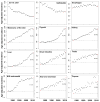Substantial contribution of extrinsic risk factors to cancer development
- PMID: 26675728
- PMCID: PMC4836858
- DOI: 10.1038/nature16166
Substantial contribution of extrinsic risk factors to cancer development
Abstract
Recent research has highlighted a strong correlation between tissue-specific cancer risk and the lifetime number of tissue-specific stem-cell divisions. Whether such correlation implies a high unavoidable intrinsic cancer risk has become a key public health debate with the dissemination of the 'bad luck' hypothesis. Here we provide evidence that intrinsic risk factors contribute only modestly (less than ~10-30% of lifetime risk) to cancer development. First, we demonstrate that the correlation between stem-cell division and cancer risk does not distinguish between the effects of intrinsic and extrinsic factors. We then show that intrinsic risk is better estimated by the lower bound risk controlling for total stem-cell divisions. Finally, we show that the rates of endogenous mutation accumulation by intrinsic processes are not sufficient to account for the observed cancer risks. Collectively, we conclude that cancer risk is heavily influenced by extrinsic factors. These results are important for strategizing cancer prevention, research and public health.
Conflict of interest statement
The authors declare no competing financial interests.
Figures









Comment in
-
Overestimating the Role of Environment in Cancers.Cancer Prev Res (Phila). 2016 Oct;9(10):773-776. doi: 10.1158/1940-6207.CAPR-16-0126. Epub 2016 Jul 19. Cancer Prev Res (Phila). 2016. PMID: 27435221
References
-
- Sell S. Stem cell origin of cancer and differentiation therapy. Critical reviews in oncology/hematology. 2004;51:1–28. - PubMed
-
- Reya T, Morrison SJ, Clarke MF, Weissman IL. Stem cells, cancer, and cancer stem cells. nature. 2001;414:105–111. - PubMed
-
- Cairns J. Mutation selection and the natural history of cancer. Nature. 1975;255:197–200. - PubMed
Publication types
MeSH terms
Grants and funding
LinkOut - more resources
Full Text Sources
Other Literature Sources
Medical
Research Materials

